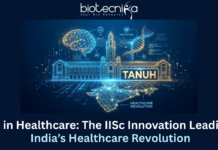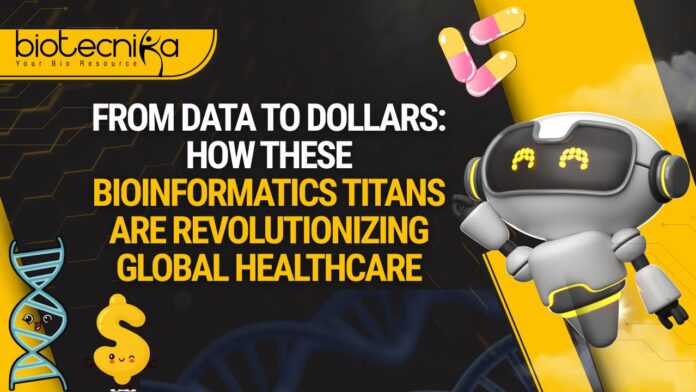Bioinformatics & Global Healthcare Revolution
Bioinformatics is revolutionizing how we understand life, turning complex Biological Data into powerful insights. As technology and Biology combine, this field is paving the way for breakthroughs in Medicine, Research, and Global Health. The global Bioinformatics market is projected to grow continuously, increasing from USD 3 billion in 2024 to USD 5 billion by 2032, with a compound annual growth rate of nearly 11%. This growth is driven by the increasing importance of data-driven decision making in Life Science, specifically in Genomics, Drug Discovery as well as Personalized Medicine. As technologies such as Next-Generation Sequencing generate massive datasets, Bioinformatics tools are becoming important for interpreting complex Biological information. The surge in healthcare innovation, disease surveillance, and precision medicine further increases the demand, positioning bioinformatics as a vital component of modern biotechnology and medical research.
Understanding the Role of Bioinformatics
Bioinformatics & Global Healthcare Revolution
Bioinformatics is the science of collecting, storing, analyzing, and interpreting vast amounts of biological data using computational and statistical tools. It supports the study of genomes, proteins, and gene expressions by making sense of large datasets that traditional lab methods alone cannot process efficiently. As technologies like next-generation sequencing (NGS) evolve, the amount of biological data being generated increases exponentially. Bioinformatics is now a cornerstone of various disciplines, including personalized medicine, agricultural biotechnology, drug discovery, and disease mechanism research.
Leading Companies Shaping the Bioinformatics Landscape
Many well-known organizations are at the forefront of driving innovation in the bioinformatics industry, shaping the future of how biological data is analyzed and applied. Leading the pack are prominent companies like Illumina, Thermo Fisher Scientific, Qiagen, BGI, Agilent Technologies, Roche, PerkinElmer, Bio-Rad, Genomatix, as well as Ginkgo Bioworks and many more. These companies are continuously pushing the boundaries by developing cutting-edge software platforms such as advanced genomics, sequencing tools, and integrated systems that improve the speed, accuracy, and reliability of Biological Data Analysis. This technology addresses complex challenges in Genomics, Proteomics, and systems biology, enabling researchers and healthcare professionals to extract deeper information from massive datasets. Beyond their internal innovations, these organizations actively engage in strategic partnerships, acquisitions, and important investments in research and development. Such collaborations and financial commitments allow them to increase the creation and deployment of novel Bioinformatics solutions, broaden their market reach, and explore new applications in Healthcare, Agriculture, and Environmental Science. Through these collaborative efforts, these leaders are not only advancing computational biology but also opening new avenues for personalized medicine, drug discovery, and biotechnology, ultimately contributing to transformative breakthroughs in life science.
How the Market Is Structured
The bioinformatics market is categorized by product type, end-use application, and geographic region. Product-wise, it is split into bioinformatics software solutions and enabling technologies such as databases and computational hardware. From an application standpoint, the primary areas of use include healthcare, particularly genomics, diagnostics, and treatment development, as well as biological research, including protein analysis, biomarker discovery, and systems biology. This structure allows market participants to tailor solutions that serve specialized industries while also supporting cross-sector applications.
Global Distribution and Regional Insights
Bioinformatics & Global Healthcare Revolution
On a global scale, bioinformatics solutions are being adopted across various regions, including North America, Latin America, Europe, Asia-Pacific, the Middle East, and Africa. North America currently leads the global market, thanks to a strong infrastructure for biotech research, high funding availability, and widespread adoption of digital health technologies. However, Asia-Pacific is expected to witness the fastest growth due to increased research spending, improving healthcare frameworks, and government initiatives promoting genomics and precision medicine in countries like China, India, and South Korea.
Opportunities and Barriers in the Market
The bioinformatics market is rapidly growing due to the rising demand for precision medicine, which depends on analyzing genetic and molecular data to personalize medicine. This rapid growth is further supported by the digitization of healthcare, as hospitals and research organizations increasingly rely on digital tools to manage complex biological data. The collaboration of AI and data science in biology is also driving innovation, enabling faster discoveries, and enhancing disease understanding. However, challenges such as handling large data sets, navigating privacy regulations as well as a shortage of interdisciplinary experts, still need to be addressed to ensure the industry’s long-term goal.
Emerging Market Trends and Use Cases
Recent trends in Bioinformatics show a rapid integration with Artificial Intelligence and Machine Learning, allowing for predictive modeling and faster data analysis. Moreover, Bioinformatics tools are embedded into smart devices for patient Health Monitoring, agricultural genomics for crop improvement, and environmental studies for Biodiversity tracking. These applications are expanding beyond traditional laboratories, enabling more dynamic, real-time solutions in diverse fields like Public Health, Forensic Science, and ecosystem conservation.
Market Forces and External Influences
A thorough evaluation of the market reveals several key forces influencing its development. The five main forces analysis highlights competition intensity, the threat of new entrants, supplier and buyer influence, and the risk of alternative technologies. The PESTLE analysis brings attention to broader Environmental factors, such as Political Regulations, economic shifts, social trends, technological advancements, legal frameworks, and sustainability efforts. These macro and micro-level forces shape the direction and stability of the bioinformatics sector.
Strategic Priorities for Industry Growth
Strategic decisions around product development, regional expansion, and digital transformation will shape the future of bioinformatics. Companies must focus on enhancing data security, ensuring compliance with international standards, and investing in user-friendly platforms. Moreover, the emphasis on collaborations with academic and clinical research institutions is growing, facilitating quicker adaptation to emerging needs in diagnostics, therapeutics, and agricultural genomics.
Conclusion and Outlook
With the exponential growth in biological data and the increasing complexity of healthcare and scientific research, the demand for robust and reliable bioinformatics platforms is projected to rise significantly. As more advanced technologies generate vast amounts of genetic, proteomic, and molecular information, researchers and clinicians require sophisticated tools to manage, analyze, and interpret this data effectively. Bioinformatics is no longer limited to clinical genomics; its applications now span a broad spectrum that includes drug development, personalized medicine, agricultural innovation, and environmental sustainability efforts such as biodiversity monitoring and ecosystem management. The continuous innovation led by industry pioneers, combined with the expanding adoption of Bioinformatics solutions all around the global markets, reinforces the sector’s crucial role in advancing Life Science. As these technologies evolve, Bioinformatics is improving healthcare outcomes and driving research discovery for the year to come.























